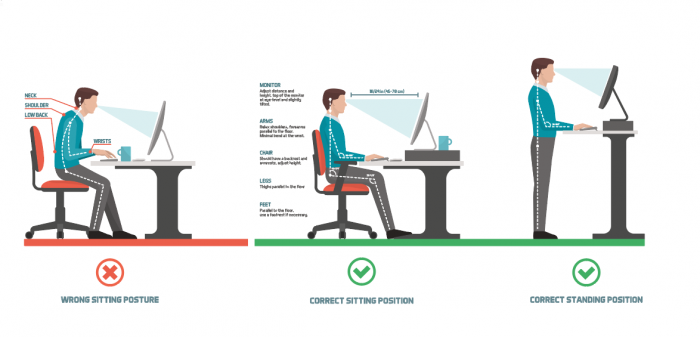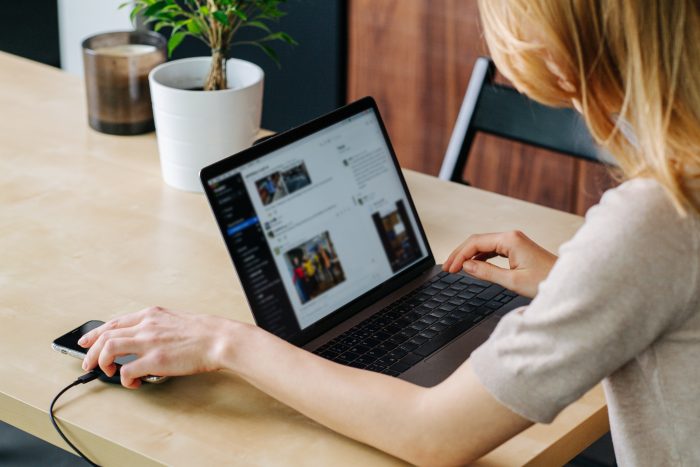Tips for suddenly finding yourself working from home all day, surrounded by family and friends
By Monica Slanik, School of Physical and Occupational Therapy
Millions of people around the globe have taken to working remotely as part of concerted efforts to practice social distancing to help flatten the curve of the COVID-19 pandemic. In many cases, people are finding themselves having to adapt and adjust to working and living in the same, sometimes confined, areas, while also trying to remain physically and mentally healthy.
Prof. Marie-Lyne Grenier, Occupational Therapist, faculty lecturer and ergonomic specialist/consultant at the McGill University Faculty of Medicine’s School of Physical & Occupational Therapy, offers the following quick tips to help maintain optimal health while working from home.
1) Staying in a seated position for too long can prevent muscles from doing what they do best, contracting and relaxing. When muscles are not activated, blood flow is reduced. Proper blood flow is necessary as it carries oxygen and nutrients to your muscles and removes waste products, such as lactic acid. When too much lactic acid accumulates, we develop aches and pains. Alternating from a seated to a standing position regularly (every 30-60 minutes) allows different muscles to contract and relax and removes that built up lactic acid in our muscles, which causes pain and discomfort.
2) To promote a change in position, try to set up a workspace that allows for both sitting and standing as illustrated in the image. If possible, set up more than one workplace in your home. If you have more than one person living at home, you can swap spaces.

3) Regular stretching also promotes blood flow and helps to prevent those aches and pains we get when performing work in a static position for too long. We usually recommend that people who work at a computer for long periods perform some stretches two times per day. You can find some useful stretches here.
4) Follow the 20/20/20 rule to decrease eye fatigue. Every 20 minutes look at an object at least 20 feet away from you for 20 seconds. This helps the eye muscles, which are focused on a computer screen (fixed distance) for long periods of time, get a break and relax.
5) Take regular 10-15-minute walks outside for some fresh air throughout your workday. Evidence shows that this helps to promote physical and mental health and boosts productivity by supporting mental alertness.
6) For your workspace, try to find a quiet spot in your home to set up. Whenever possible, find a space that allows for natural sunlight and a comfortable setting. Make a Meeting in Progress sign and place it on your door whenever you are meeting with others so that other people in your home know not to disturb you.
Have a conversation with other people in your home ahead of time to explain that you are now working/studying from home and will need some quiet time for various meetings during the day.
Suggestion: have children make different signs for different meetings (30-minute meeting, 1-hour meeting etc.)
7) Maintain a healthy posture by taking the time to arrange your workspace so that it is comfortable for you, paying special attention to maintaining the natural curves of your spine.
Here are fact sheets for ideal posture positions for sitting and standing.
8) Find a series of games, puzzles or crafts for your children to do only while you are on video conference calls which can’t be interrupted. Make different signs so that kids know how long your meeting will last, or as suggested above, have your children make the signs for you.
9) Stay hydrated! Working from home should provide you with easy access to healthy drinks like water, tea and juices. Make sure to stay hydrated throughout the day.
10) Don’t spend your lunch hour in front of the computer. Working from home is a great way to eat healthily and spend time with your loved ones. This may be your opportunity to learn new recipes and spend some time cooking and eating a healthy lunch together.
11) If you have pets at home, they are sure to be happy to have you there. Taking a few walks throughout the day with your dog(s) is a great way to get some exercise (for both of you) while spending quality time with your furry friend.
12) Try to maintain a regular sleep schedule by setting an alarm to wake up at your regular work time each day. It can be tempting to stay up late when working from home but maintaining a regular sleep schedule maintains your regular wake-sleep cycle that will make the transition back to work easier once social distancing restrictions are lifted.
13) Interested in learning a new skill? Take advantage of working from home! Want to spend more time doing something as a family? Take that 1-2 hour commute you usually do and spend it learning something new, working on a craft project you’ve been wanting to get done, or enjoying a leisure activity that you may not always have the time to do. Learning something new or doing a new activity together will most probably be a welcome distraction in this exceptional and challenging time.
14) Try, as much as possible, to schedule time away from all devices, even if for brief periods. In today’s world, many of us are connected online for work and leisure. Finding yourself suddenly working remotely you may feel expected to respond at all hours. This is not always the case, do remember to take time out and connect with something other than your device. A walk outside can be really helpful!
Marie-Lyne Grenier, MScOT, DOT, erg. is a faculty lecturer with experience teaching in an online format. Marie-Lyne has offered continuing professional development regarding ergonomics to professional dentist associations, dental hygienist associations and professional podiatry associations.
Monica Slanik, BSc(Bio), BSc(OT) has been working remotely since 2012 in various capacities. She is currently a program administrator and does the instructional design for the Online Graduate Certificates and Continuing Professional Development at the School of Physical & Occupational Therapy, social media manager and works on various communications projects.

March 20 2020

